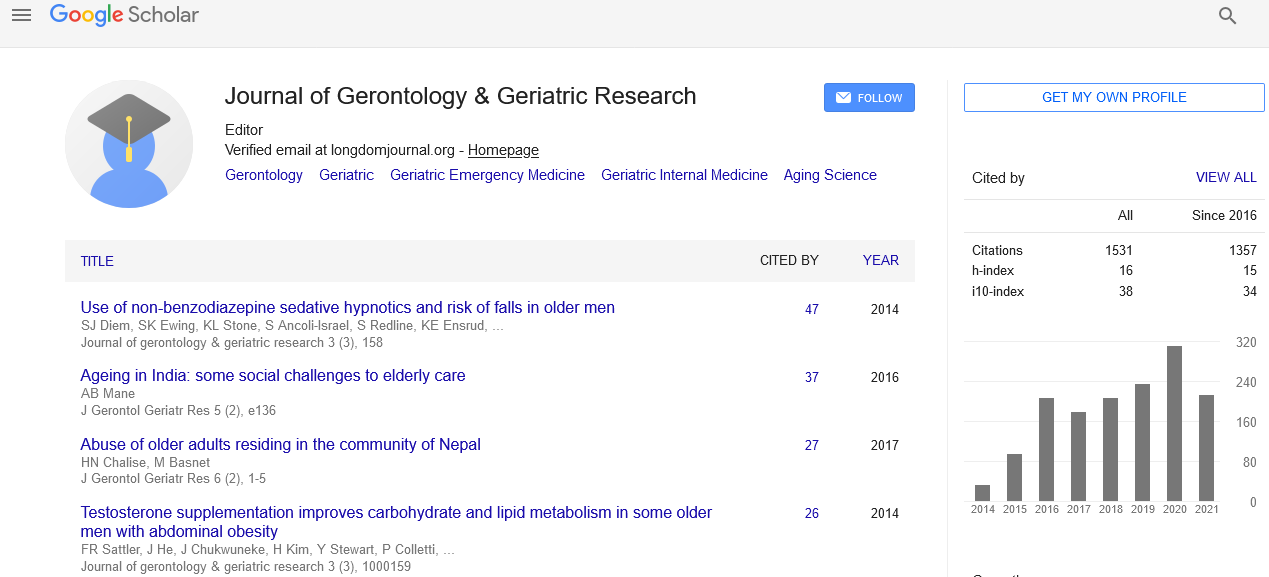PMC/PubMed Indexed Articles
Indexed In
- Open J Gate
- Genamics JournalSeek
- SafetyLit
- RefSeek
- Hamdard University
- EBSCO A-Z
- OCLC- WorldCat
- Publons
- Geneva Foundation for Medical Education and Research
- Euro Pub
- Google Scholar
Useful Links
Share This Page
Journal Flyer

Open Access Journals
- Agri and Aquaculture
- Biochemistry
- Bioinformatics & Systems Biology
- Business & Management
- Chemistry
- Clinical Sciences
- Engineering
- Food & Nutrition
- General Science
- Genetics & Molecular Biology
- Immunology & Microbiology
- Medical Sciences
- Neuroscience & Psychology
- Nursing & Health Care
- Pharmaceutical Sciences
MEA-Based quantitative measurement of the electrophysiological activity of spiking cells
International Conference on Geriatrics & Gerontology
July 08-10, 2014 DoubleTree by Hilton Hotel Chicago-North Shore Conference Center, USA
Xiao-Ying Lu and Zhi-Gong Wang
Scientific Tracks Abstracts: J Gerontol Geriat Res
Abstract:
Since all bodies of youth and elders consist of different cells, and cells behave differently under varying conditions, the study of these behaviors is critical for understanding their influence on the body performance. In this talk, a method is proposed for the quantitative measurement of the electrophysiological performance of spiking cells. The aim is to study the influence of different environmental factors on the electrophysiology of a certain class of cells. The basic concept is to measure the threshold of the stimulation voltage impulses which evoke a patterned response signal. Micro-electrode arrays (MEAs) have been developed and used to test PC12 cells, one type of spiking cells. The alcohol concentration and the temperature of the culture medium have been selected as the influence factors. The spiking activities of PC12 cells have been studied under a range of different conditions. The alcohol concentration experiment shows that with concentrations of 7.5 mmol/L and up the voltage stimulation threshold increases almost linearly with increased alcohol concentration, resulting in lower spiking activity at higher alcohol concentration The temperature experiment shows a distinctive relationship curve for the voltage stimulation threshold versus temperature in the range from 34?C to 42?C, which corresponds to possible body temperature. This curve could explain why fever patients could be woolly-headed and become insensitive with temperatures over 41?C. Thus, the validity of the proposed method is demonstrated and a series of useful results have been obtained for the quantitative evaluation of the electrophysiological activity of spiking cells.
Biography :
Xiao-Ying Lu is Doctoral Supervisor, Vice-Director of State Key Laboratory of Bioelectronics, director of Biomaterial and Biocompatibility Institute, Southeast University. She graduated from the Dentistry Department of Shanghai Second Medical University in 1980, and obtained her Master of Medicine in 1986 there. In 1986 she went to Ruhr University, Bochum, Germany for further study. In 1996 she got her Dr. Dent. Degree from Albert-Ludwig University, Freiburg, Germany. Since 1997, she has been working in Southeast University, China, in the area of biomaterials and biocompatibility. She is member of ?Standing Council of Dental Materials Committee of Chinese Stomatological Association? and member of ?Biomaterial Committee of Chinese Society of Biomedical Engineering?.


